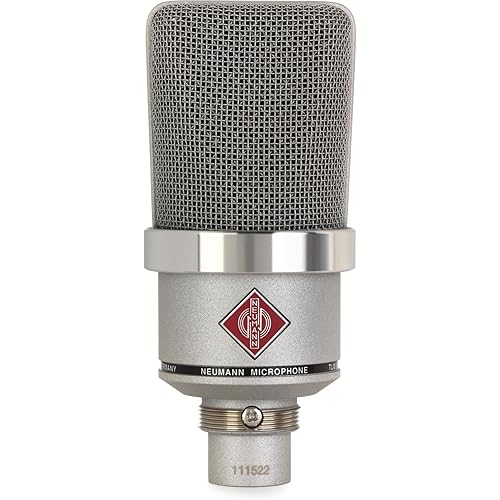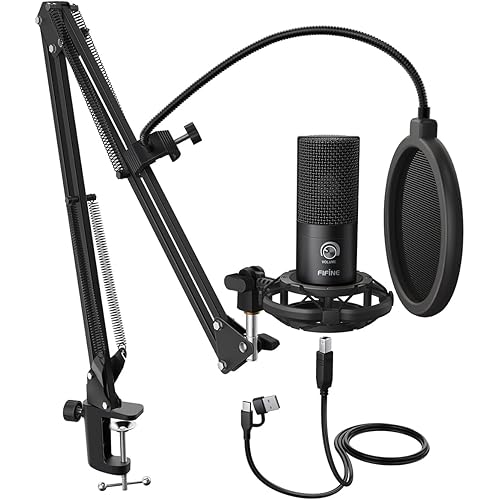

Buy Now, Pay Later
- – 6-month term
- – No impact on credit
- – Instant approval decision
- – Secure and straightforward checkout
Ready to go? Add this product to your cart and select a plan during checkout.
Payment plans are offered through our trusted finance partners Klarna, Affirm, Afterpay, Apple Pay, and PayTomorrow. No-credit-needed leasing options through Acima may also be available at checkout.
Learn more about financing & leasing here.
Selected Option
30-day refund/replacement
To qualify for a full refund, items must be returned in their original, unused condition. If an item is returned in a used, damaged, or materially different state, you may be granted a partial refund.
To initiate a return, please visit our Returns Center.
View our full returns policy here.
Recently Viewed
Color: Silver
Style: C-3
Pattern Name: Microphone
Features
- Medium Dual-Diaphragm Condenser Microphone With Cardioid
- Omnidirectional Figure-eight Pickup Patterns
- Pressure-gradient transducer with shock-mounted dual-diaphragm capsule
- Perfect for acoustic instruments, overhead, piano, etc
Description
Dual-Diaphragm Studio Condenser Microphone The C-3 is a home recording enthusiast's dream come true. This professional- quality condenser microphone is designed to capture your sounds with incredible realism, sensitivity and accuracy. This professional-quality condenser microphone is designed to capture your sounds with incredible realism, sensitivity and accuracy. Click to enlarge. View frequency response. Click to enlarge. View polar pattern. Click to enlarge.What is a Condenser Mic? Condenser microphones are the ideal choice for capturing vocals and acoustic instruments. They're the primary type of microphone used in recording studios and radio stations. They are capable of capturing much more detail than dynamic microphones because of their wider, flatter frequency response. Another difference between condenser and dynamic mics is they contain active circuitry that requires phantom power (+48 V DC) for operation. You can power them from any phantom power equipped BEHRINGER XENYX mixer, plus enjoy the benefits of our state-of-the-art XENYX mic preamps. Why the C-3? The C-3 is an affordable, high-quality way to put this essential studio tool to work for you. It has three selectable pickup patterns: omnidirectional for capturing sound equally on all sides; cardioid for picking up your source signal while rejecting off-axis sounds; and figure-eight for capturing sound both behind and in front of the mic, but not all the way around. With its excellent transducer and gold-plated XLR output, the C-3 is very neutral-sounding and truly delivers on the promise of noise-free transmission. Built To Last The C-3 is built to be your go-to condenser mic for years to come. Its tough, die- cast body can withstand all the rigors of bleary-eyed late-night recording marathons. And with its rugged foam-padded carrying case, it travels in safety and style. We also included a swivel stand mount so it can be affixed to your studio's mic stands. C-3 Specs Transducer type: Condenser, 16 mm Polar pattern: Cardioid, figure 8, omni Connection: Gold-plated balanced XLR connector Open circuit sensitivity: -40 dBV/pa (10 mV/pa) Frequency response: 40 Hz - 18 kHz Max. SPL: 142 dB Equivalent noise level: 23 dBA (IEC 651) Dynamic range: 119 dB Rated Impedance 350 ohms Supply voltage: +48 V Supply current: 7.0 mA Dimensions: Shaft diameter: 54 mm; Length: 180 mm Weight: Approximately 0.45 kg What's in the Box Behringer C-3 Microphone, Swivel Stand Mount, Carrying Case, User's Manual
Recommended Uses For Product: Voice Recording, Video Recording
Brand: Behringer
Model Name: C-3
Connectivity Technology: XLR
Connector Type: XLR
Special Feature: Stand
Compatible Devices: Radio
Color: Silver
Included Components: Dual Diaphragm Studio Condenser Microphone
Polar Pattern: Multipattern
Item Weight: 14.88 ounces
Microphone Form Factor: Microphone Only
Item dimensions L x W x H: 2.13 x 2.13 x 7.09 inches
Power Source: Corded Electric
Material: Metal
Signal-to-Noise Ratio: 7E+1 dB
Number of Channels: 1
Frequency Response: 18 KHz
Global Trade Identification Number: 10, 55
Manufacturer: Behringer
UPC: 689076112710
Item Weight: 14.9 ounces
Product Dimensions: 2.13 x 2.13 x 7.09 inches
Item model number: C-3
Is Discontinued By Manufacturer: No
Date First Available: December 4, 2007
Color Name: Silver
Material Type: Metal
Frequently asked questions
To initiate a return, please visit our Returns Center.
View our full returns policy here.
- Klarna Financing
- Affirm Pay in 4
- Affirm Financing
- Afterpay Financing
- PayTomorrow Financing
- Financing through Apple Pay
Learn more about financing & leasing here.





















